
Golan subtitled "Syrian-Israeli Combat in the '73 War", is a board wargame published by Simulations Publications, Inc. (SPI) in 1975 that simulates operational level ground combat between Egypt and Israel on the Golan Heights during the just completed Yom Kippur War of October 1973. Golan was originally published as part of the "quadrigame" Modern Battles: Four Contemporary Conflicts.
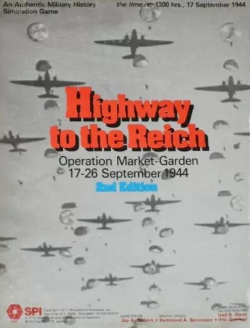
Highway to the Reich is a grand tactical monster board wargame published by Simulations Publications, Inc. (SPI) in 1976 that simulates the World War II Allied operation known as Operation Market Garden.

Napoleon's Last Battles is a board wargame published by Simulations Publications in 1976 that simulates the last four battles fought by Napoleon. It was one of SPI's most popular games, and also received many positive reviews.

Marengo: Napoleon in Italy, 14 June 1800 is a board wargame published by Simulations Publications Inc. (SPI) in 1975 as one of four games packaged together in the Napoleon at War "quadrigame". Marengo was also released as a separate game the same year. The game simulates the Battle of Marengo between Austrian and French forces.
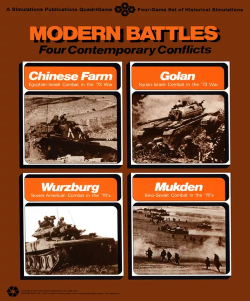
Modern Battles: Four Contemporary Conflicts is a collection of four board wargames published by Simulations Publications Inc. (SPI) in 1975 that simulates four modern-day battles set in the early 1970s.

Napoleon at War, subtitled "Four Battles", is a collection of four board wargames published by Simulations Publications Inc. (SPI) in 1975 that simulates various battles fought by Napoleon.

Napoleon at Waterloo is a board wargame published by Simulations Publications Inc. (SPI) in 1971 that simulates the Battle of Waterloo. The game, which features simple rules, was designed as an introduction to board wargaming, and was given as a free gift with each subscription to SPI's Strategy & Tactics magazine.

Breitenfeld, subtitled "Triumph of the Swedish System", is a board wargame published by Simulations Publications Inc. (SPI) in 1976 that simulates the 1631 Battle of Breitenfeld during the Thirty Years' War. Breitenfeld was a free game that appeared in Strategy & Tactics, designed to promote SPI's soon-to-be-launched wargame Thirty Years War. Breitenfeld proved popular and was also published as part of SPI's "folio" series of games.

Westwall: Four Battles to Germany is a collection of four board wargames published by Simulations Publications (SPI) in 1976 that simulate battles in Europe in late 1944 and early 1945 during World War II.

Blue & Gray II, subtitled "Four American Civil War Battles", is a collection of four board wargames originally published by Simulations Publications, Inc. (SPI) in 1975 that each simulate a battle from the American Civil War. It is the sequel to Blue & Gray published earlier in the year. Each of the four games was also published as individual "folio games."
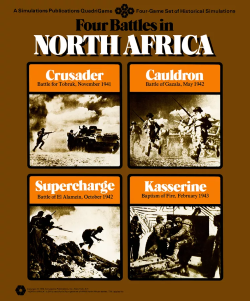
Four Battles in North Africa is a collection of four board wargames published in 1976 by Simulations Publications, Inc. (SPI) that simulate various battles during the North African Campaign of World War II.

Hurtgen Forest, subtitled "Approach to the Roer, November 1944 ", is a board wargame published by Simulations Publications Inc. (SPI) in 1976 that simulates the Battle of Hürtgen Forest during the final year of World War II. The game was originally published by SPI as part of a four-game collection titled Westwall: Four Battles to Germany, but it was also released as an individual "folio game." While the quadrigame Westwall received good reviews from critics, the static nature of Hurtgen Forest was less well received.
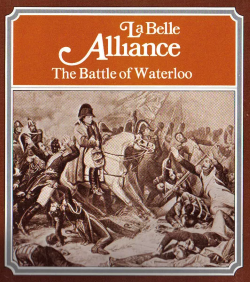
La Belle Alliance: The Battle of Waterloo is a board wargame published by Simulations Publications Inc. (SPI) in 1976 that simulates the Battle of Waterloo in 1815. It was one of four games that were published as part of the "quadrigame" titled Napoleon's Last Battles, but was also released as an individual "folio game", packaged in a shrinkwrapped cardboard folio.

The Battle of Nations, subtitled "The Encirclement at Leipzig, 16–19 October 1813", is a board wargame published by Simulations Publications Inc. (SPI) in 1975 that simulates the Battle of Leipzig in 1813. It was one of four games that were published as part of the "quadrigame" titled Napoleon at War, but was also released as a "folio game", packaged in a shrinkwrapped cardboard folio. It was popular in a 1976 poll of favorite wargames, and critics also gave it favorable reviews.

Bastogne: The Desperate Defense, December 1944 is a board wargame published by Simulations Publications, Inc. (SPI) in 1976 that simulates the German attack on Bastogne during World War II's Battle of the Bulge. The game was originally part of the four-game collection Westwall: Four Battles to Germany, and was also released as a stand-alone "folio" game.

Wavre: The Opportunity Lost is a board wargame published by Simulations Publications Inc. (SPI) in 1976 that simulates the Battle of Wavre. Wavre was originally published as one of four games in the popular collection Napoleon's Last Battles, but was also released as an individual game.

Cauldron: Battle of Gazala, May 1942 is a board wargame published by Simulations Publications Inc. (SPI) in 1976 that simulates the Battle of Gazala during World War II. The game was originally published as part of the Four Battles in North Africa "quadrigame" — a gamebox containing four games simulating four separate battles that all use the same rules. Cauldron was also published as an individual "folio game."

Crusader: Battle for Tobruk, November 1941 is a board wargame published by Simulations Publications Inc. (SPI) in 1976 that simulates Operation Crusader during World War II. The game was originally published as part of the Four Battles in North Africa "quadrigame" — a gamebox containing four games simulating four separate battles that all use the same rules. Crusader was also published as an individual "folio game."

Remagen: Bridgehead on the Rhine, March 1945 is a board wargame published by Simulations Publications Inc. (SPI) in 1976 that simulates the Battle of Remagen during World War II. The game was originally published as part of the Westwall: Four Battles to Germany "quadrigame" — a gamebox containing four games simulating four separate battles that all use the same rules. Remagen was also published as an individual "folio game."
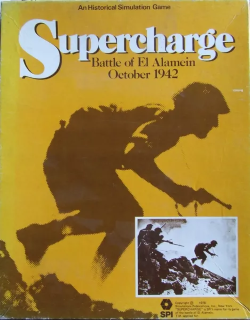
Supercharge: Battle of El Alamein, October 1942 is a board wargame published by Simulations Publications Inc. (SPI) in 1976 that simulates Operation Supercharge during the Second Battle of El Alamein of World War II. The game was originally published as part of the Four Battles in North Africa "quadrigame" — a collection of four games simulating four separate battles that all use the same rules. Supercharge was also published as an individual "folio game."





















